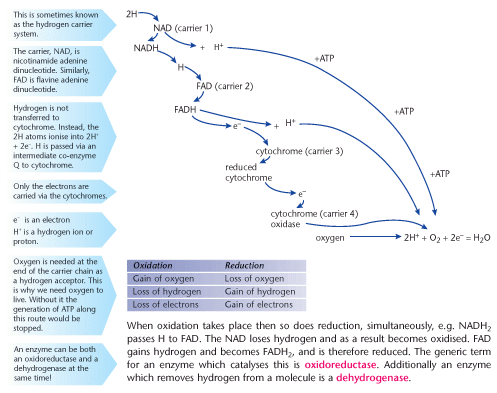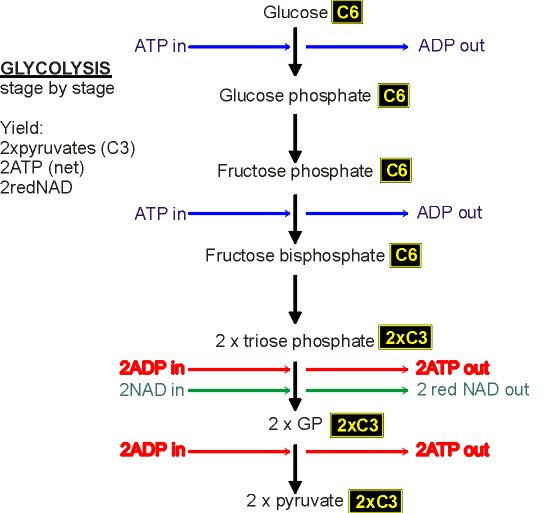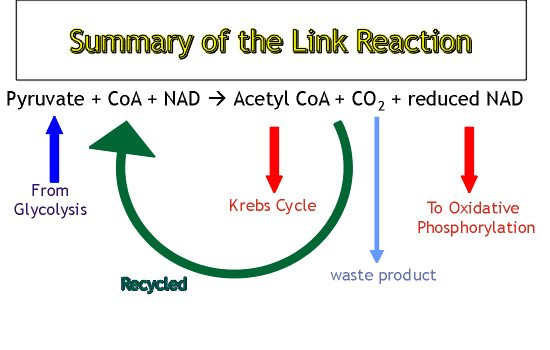Glycolysis and the Krebs cycle
Both processes produce ATP from substrates but the Krebs cycle produces many more ATP molecules than glycolysis! Every stage in each process is catalysed by a specific enzyme. In aerobic respiration both glycolysis and the Krebs cycle are involved whereas in anaerobic respiration only glycolysis takes place.
The flow diagram shows that every time a stage produces two hydrogen atoms, in the presence of oxygen, three ATP molecules are produced. The role of these hydrogen atoms is shown in the electron carrier system.
Electron carrier system
The main feature of the electron carrier or electron transport system is that three ATPs are produced every time 2H atoms are transported. It takes place in the mitochondria.

Glycolysis – summary
ALL THE REACTIONS IN GLYCOLYSIS TAKE PLACE IN THE CELL CYTOPLASM (OUTSIDE THE MITOCHONDRION)
- Glucose is a stable molecule containing 6 Carbon atoms
- Glucose contains many C-H bonds and contains significant energy
- During GLYCOLYSIS one glucose molecule is split into two PYRUVATE molecules.
- Each PYRUVATE molecule contains three carbon atoms

- As glucose is a stable molecule it must first be made into a less stable FRUCTOSE BISPHOSPHATE molecule before it can be broken down. This requires the input of energy
- (2 x ATP)
- FRUCTOSE BISPHOSPHATE is split into two TRIOSE PHOSPHATE molecules
- The two TRIOSE PHOSPHATE molecules are converted into two GP molecules, releasing energy (2 x ATP), and Hydrogen. Hydrogen is picked up by NAD to form reduced NAD (redNAD). The Hydrogen is taken to the mitochochondria where is is used to generate
- ATP by OXIDATIVE PHOSPHORYLATION
- 2GPs are converted into two PYRUVATE molecules releasing energy (2 x ATP).
Thus at the end of GLYCOLYSIS, one glucose mocule has generated
- 2 pyruvate molecules (to the LINK REACTION)
- 2 ATP molecules (2 input, 4 output)
- 2 red NAD molecules (to OXIDATIVE PHOSPHORYLATION)
- NO CO2 is produced by glycolysis
The LINK REACTION
Overview
- Pyruvate from glycolysis is converted to Acetyl Coenzyme A (acetyl CoA)which enters the Krebs Cycle
- No ATP is generated
- H is released producing reduced NAD for Oxidative Phosphorylation
- CO2 is released
The LINK REACTION step by step
-
Pyruvate(X2) is produced in the cytoplasm by glycolysis
-
It is moved by active transport into the mitochondrial matrix
-
A series of chemical changes occur:
-
decarboxylation (CO2 removed) by pyruvate decarboxylase
-
Dehydrogenation (H removed) by pyruvate dehydrogenase
-
An Acetyl group (2C) is produced which reacts with Coenzyme A to form Acetyl CoA
-
-
Acetyl CoA is the end product of the Link Reaction and is needed for the next stage of cell respiration: Krebs cycle (also called the Citric Acid cycle)
-
note that the Coenzyme A is not used up in the Krebs Cycle but is recycled back to the link reaction to make another Acetyl CoA molecule - thus Coenzyme A acts as a carrier for the acetyl molecule
The Yield of the Link Reaction
-
- One CO2 molecule per pyruvate (waste product)
-
- One (2 carbon) Acetyl group per pyruvate for Krebs Cycle
-
- One reduced NAD molecule per pyruvate for Oxidative Phosphorylation

Acetyl Coenzyme A
Coenzyme A is made up of vitamin B5 (pantothenic acid), Adenine and Ribose.
CoA carries the acetyl group (as Acetyl CoA) from glycolysis to Krebs cycle and is repeatedly recycled
Most molecules used by living organisms for energy are converted into Acetyl CoA
Respiration of Fats
Fats → Fatty acids and glycerol
Glycerol → triose phosphate for glycolysis
Fatty acids → 2C chunks → acetyl CoA to Krebs Cycle
In reverse - excess Carbohydrate can be converted into fats via acetyl CoA
Krebs Cycle Overview
- Also known as the Citric Acid cycle, it was discovered in 1937 by Hans Krebs
- Krebs Cycel is a series of 9 enzyme controlled reactions that breakdown Acetyl CoA into CO2
- Krebs Cycle occurs in the mitochondrial matrix
-
The 2C Acetyl molecule is broken down into:
- 2 x CO2 molecules (waste product)
- releasing energy to build up 2ATP molecules,
- releasing H carried by NAD (red NAD) and FAD (red FAD) to generate more ATP via oxidative phosphorylation
Krebs Cycle Step by Step
- The (2C) acetyl group from AcetylCoA combines with (4C) oxaloacetate to make (6C) citrate
- Citrate is decarboxylated (removal of CO2) and dehydrogenated (removal of Hydrogen) to give a 5C compound, CO2 and reduced NAD.
- Further decarboxylation and dehydrogenation gives the 4Carbon compound oxaloacetate, CO2, reduced NAD, reduced FAD and ATP.
- The 4C oxaloacetate combines with a new molecule of acetyl CoA and the cycle starts again – hydrogen carriers take H to the electron transport chain.
